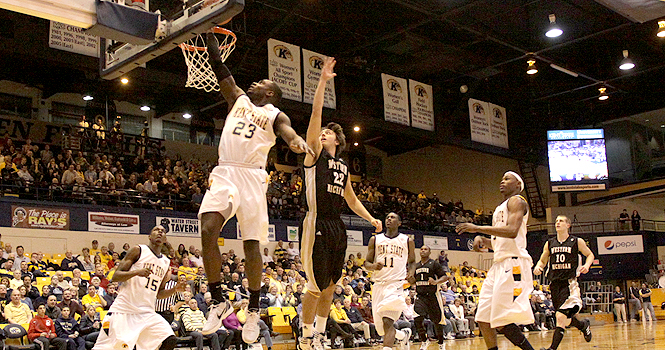Kent State basketball: season in review
Kent State forward Patrick Jackson makes his way through the Western Michigan defense during the Feb. 4 game at the M.A.C. Center. The Flashes won the game 78-77 against the Broncos. Photo by Brian Smith.
April 3, 2012
Kent State began a 2011-12 season with big expectations but ended it quietly.
The Flashes lost only one player from their 2010-11 Mid-American Conference regular season championship team, and were expected to be even more successful in 2011-12. Kent State returned the MAC Player of the Year in forward Justin Greene, the MAC Defensive Player of the Year in guard Michael Porrini and the MAC Sixth Man of the Year, guard Carlton Guyton. The athletic department promoted the team with the motto “Unfinished Business,” as the Flashes were looking to avenge their overtime loss to rival Akron in the MAC Championship.
Kent State began the season with an upset win over Big East power West Virginia in Morgantown, W.Va. The victory started a season that held plenty of promise for the defending MAC East Division champions.
But Kent State never did finish its business in 2011-12, losing to Akron twice in the regular season, and a third time in the semifinals of the MAC Tournament. A lackluster performance in the CollegeInsider.com Tournament opening round, a 73-58 loss to USC Upstate, ended the Flashes’ disappointing season.
“Each of the Akron games, we had leads,” coach Rob Senderoff said. “At home, we were up nine at halftime. Had we found a way to win that game, I think the tournament bracket would have been different. When you get in the MAC Tournament, or any tournament, who you play and when you play them has a lot to do with the outcome. Akron had our number; they beat us at their place, at our place and on a neutral floor.”
“[The third loss to Akron] hurt us a lot because we knew we couldn’t win the regular season, but we could keep [Akron] from winning it,” Porrini said. “We were playing good in the first half, but the same thing happened [as in the first two losses], and they hit the shots they needed to hit at the right time. Instead of bouncing back on the defensive end, we allowed it to affect our offense.
“All three of [the losses to Akron] hurt, but it hurt me more because it was my last home game, and the way that we lost, it hurt us a lot.”
Senderoff was quick to point out that Kent State wasn’t the only team to finish the year with difficult losses.
“If you look at Akron, they lost five of their last seven games,” Senderoff said. “Cleveland State lost six of their last eight games. You can go on and on. There’s only one team in our league that at the end of the year is really happy, and that’s OU, because they went to the tournament and had a great run in the tournament. Outside of that in our league, there’s 11 teams that are disappointed in some way.”
With such big expectations, many wondered why Kent State never quite reached its full potential. As with any team, injuries factored into the outcome of the regular season. The Flashes had their share of injuries, with Porrini dealing with a foot injury for much of the season.
“There was a stretch during the season where his foot was really bothering him,” Senderoff said. “He didn’t play much against Utah State. [Against] Arkansas State, he wasn’t healthy in that game, and just sort of played through it the rest of the year.”
Greene sprained his ankle in a game versus Buffalo on Feb. 14, but missed only one game, an 80-73 home loss to the College of Charleston. The senior forward played through pain for the latter portion of the season, but he was unaware of the extent of the injury, which was revealed after the conclusion of the season.
“We didn’t know he had a stress fracture until after the year,” Senderoff said. “But he obviously missed a game and was hobbling around for basically the last month of the year…He just wasn’t 100 percent after that point.”
Guyton suffered an injury before the beginning of the season, which may have contributed to his lower numbers in 2011-12.
“In preseason, he took a shot to the head, missed a number of days and actually was in the hospital at one point,” Senderoff said.
“Everybody has injuries, so we can’t blame the outcome on injuries,” Porrini said. “We had to fight through a lot of injuries, but we don’t want to make that the focal point on why our season was what it was.”
But injuries weren’t the lone culprit for Kent State’s disappointing season. The loss to Charleston ended a seven-game winning streak, and the Flashes were never the same.
“I think the Charleston loss was a huge turning point,” Porrini said. “We took a home loss in front of our 2002 Kent State team. It was a big night for us, and we let ourselves down. After that, it wasn’t a good outcome.
“I feel like it took a lot of air out of us at that time. The loss hurt a lot, but we were supposed to be able to bounce back from it and get a win, but we couldn’t do that.”
“Some of it was we didn’t play as well toward the end, some of it was the teams we played were good,” Senderoff said. “We just didn’t play as well for a variety of reasons. Injuries might have had something to do with it, but we didn’t defend as well as we were defending. I think that had more to do with it than anything. We just didn’t defend the way we had been prior [to the Charleston loss]. We turned the ball over too much toward the end of the year as well. Injuries may have had something to do with that, but I don’t know about that.”
Senderoff pointed out the positives in Kent State’s disheartening season.
“At the end of the day, we won 21 games, which was the third most in our league,” Senderoff said. “We were 12-3 at home. We beat West Virginia for probably the school’s best non-conference win in 40 years. There’s a lot of accomplishments we had. We just didn’t get to the NCAA Tournament, which is unfortunate.
“We had our chances, we just didn’t close out the way we would have liked to.”
A coaching change also impacted the Flashes’ season, although the transition wasn’t as drastic, considering that the change was made within the program following Geno Ford’s departure for Bradley.
“The first year [as a head coach] is going to be different,” Senderoff said. “Whether it’s within the program or to another program, you have different things that you’re responsible for. In terms of preparing every day for practice, for games, dealing with the players and media, all those things are different. There’s a lot of things I learned.
“I don’t know that there’s a lot of things that I would do differently, but I’m sure there are some things I would do differently in retrospect. [Kansas’] coach [Bill] Self, I don’t know him very well, but I’m sure there’s things he would do differently, next year than he would do this year, and he’s been doing this a long time. I think it’s just the nature of trying to get better.”
Improvement, which begins with weight lifting and practice, is the focus of Senderoff and his players during the offseason.
“We’re lifting four days a week, and there’s no excuses or anything in the weight room,” Senderoff said. “We’ve just got to make sure we’re mentally and physically tougher. We’re trying to make sure our kids get better individually on the court.”
Kent State turns to next season with optimism, thanks to the return of sharp-shooting guard Randal Holt and electrifying forward Chris Evans.
“I know Randal is obviously a returning starter,” Senderoff said. “We have a lot of guys who played and are returning, but nobody other than Randal who was a starter. Those guys are going to have to earn their minutes and prove their value, and it’ll start by how they defend and how hard they’re practicing and working from this point on.”
Senderoff is also encouraged by the upcoming arrival of a recruiting class that features four early signings.
Khaliq Spicer, an athletic, 6-foot-9 forward, signed with the program, along with guard Kellon Thomas, who Senderoff described as a “tough, hard-nosed kid” who also played football in high school.
Junior college recruit Darren Goodson, a 6-foot-5 forward, is a “big, physical, mobile” scorer, Senderoff said. Chris Ortiz, 6-foot-7 forward, rounds out the class for now, which is filled with size.
“We need to [add tall players], because we graduated Justin Manns and Justin Greene, who played a lot of minutes up front for us,” Senderoff said. “We need to replace those guys, for sure.”
Forward Scooter Johnson is the lone confirmed transfer at this point, but may not be the only one to leave Kent State.
“We’re still having meetings with other players, going through that process,” Senderoff said.
Roster turnover aside, the aspirations of the Kent State basketball program will remain the same in 2012-13.
“We’re going to try to do our best to compete for the league again, like we do every year,” Senderoff said. “That’s our goal. We’ll be young and have new faces, and we’ll have to see how everybody does academically this spring, during the summer, who has gotten better and who has worked hard, and see where we’re at.
“Our goals will be the same. Our goal is to go to the NCAA Tournament. That will be our goal every year.”
Contact AJ Atkinson at [email protected] or @AJ_Atkinson1.












